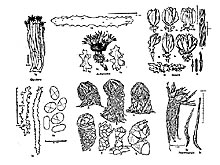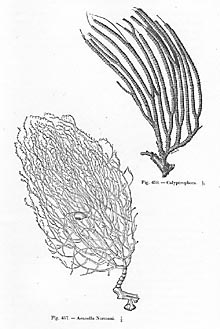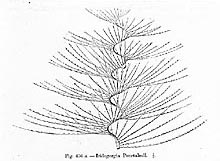
Figure 1: Octocoral colonies can grow in a variety of sizes and shapes. Soft corals or sea fans often grow into large structures. Click image for larger view.
Deep Water Octocorals
Les Watling, Benthic Ecologist
Darling Marine Lab, University of Maine
Octocorals—the sea fans of tropical reefs—are classified within the Phylum Cnidaria and Class Anthozoa. All anthozoans are benthic, polyp-bearing corals and, unlike sea jellies and most hydroids, have no medusa stage. Each polyp on an octocoral (octo means eight) has eight hollow tentacles fringed with little branches called pinnules. This feature distinguishes octocorals from hard corals, which have simple tentacles in multiples of six.

Figure 2: All corals have skeletons made of calcium carbonate, the same material that composes sea shells. This diagram shows the various forms of coral skeletons. Click image for larger view.
Octocorals are divided into three groups—blue corals, sea pens, and soft corals and sea fans. Blue corals live only in the shallow tropics. But sea pens, soft corals, and sea fans can live in deep water as well as in shallow tropical or cold waters. In this expedition, we will concentrate on soft corals and sea fans.
We likely will see several growth forms among the soft corals and sea fans (see Fig. 1). The smallest types are the creeping forms, such as Clavularia, which grows on the surfaces of rocks and stones. We may also see the more erect but relatively small axial polyp form that develops secondary polyps along its sides. The largest growth forms that we may see are the fleshy mass types, such as Anthomastus, and the erect sea fan (gorgonian) types.

Figure 3: Coral colonies were often found and brought to the surface during some of the earliest explorations of the deep sea. Click image for larger view.
Many species of sea fans live in deep water. The sea fans are not always fan-shaped, however. Some look like small trees, and others are fondly called “bottle brushes” because they have branches that radiate in all directions from a central axis. Usually, bottle brush corals have very small polyps. The polyps of other sea fans and soft corals, however, are larger.
We know very little about the biology of deep water octocorals, but what we do know indicates that they are similar to octocorals in shallow tropical seas. Their skeletons are made up of an array of small skeletal formations (sclerites) (see Fig. 2), which are sometimes augmented by a horny organic substance known as gorgonin. However, deep water octocorals do not possess symbiotic algae (zooxanthellae) that shallow-water corals have within their tissues. These photosynthetic algae allow shallow-water coral to photosynthesize to create food. But in deep water, light is dim, if not completely absent. Thus, all deep and cold water octocorals feed on food particles that pass through the water. Scientists have not yet studied the process of particle capture in detail.

Figure 4: Coral colonies were often found and brought to the surface during some of the earliest explorations of the deep sea. Click image for larger view.
Most octocorals have large, erect bodies that extend upwards into the water. The corals' large bodies help the polyps to capture food from the water as it passes by the colony. Other animals, such as brittle stars and marine worms, live on the octocoral bodies, allowing them better access to more food particles. In some cases, however, these animals may be feeding on the small coral polyps themselves.
Scientists have studied primarily tropical octocorals, so we expect to see many types in the deep water that have not been adequately studied. Some families that are common in deep water of the Atlantic include Anthothelidae, Acanthogorgiidae, Paragorgiidae, Plexauridae, Ellisellidae, Primnoidae, Chrysogorgiidae and Isididae. Several of the genera represented in these families are illustrated in Figures 3 and 4. These types were recovered between 1877 and 1880 during cruises conducted by the U.S. Coast and Geodetic Survey's steamer ship Blake.
More information and a complete classification of octocorals is available on Gary Williams' octocoral Web site ![]() at the California Academy of Sciences.
at the California Academy of Sciences.



















